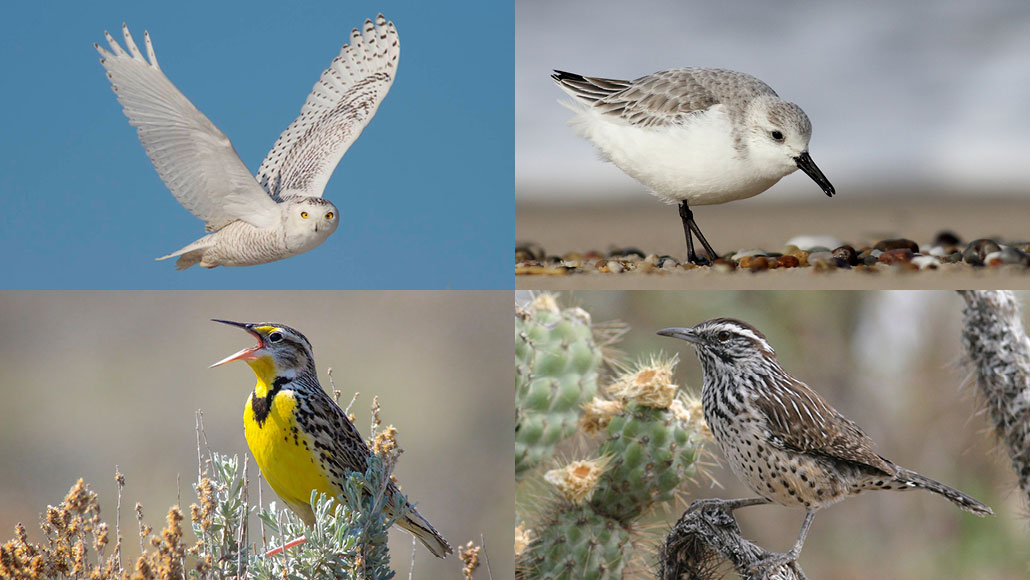
Populations of rare and common birds alike are decreasing across North America, including (clockwise from top left) snowy owls, sanderlings, cactus wrens and Western meadowlarks.
Clockwise from top left: Doug Hitchcox, Andy Eckerson, Brian Sullivan, Matthew Pendleton/Macaulay Library at Cornell Lab of Ornithology
- More than 2 years ago
Nearly 3 billion fewer birds exist in North America today than in 1970.
While scientists have known for decades that certain kinds of birds have struggled as humans (and bird-gobbling cats) encroach on their habitats, a new comprehensive tally shows the staggering extent of the loss. Nearly 1 in 3 birds — or 29 percent — has vanished in the last half century, researchers report September 19 in Science.
“Three billion is a punch in the gut,” says Peter Marra, a conservation biologist at Georgetown University in Washington, D.C. The loss is widespread, he says, affecting rare and common birds alike. “Our study is a wake-up call. We’re experiencing an ecological crisis.”
Looking at the loss of individual birds sets this study apart, says Hillary Young, an ecologist at the University of California, Santa Barbara who was not involved in the study. “So much of the focus in conservation is on the loss of species,” but individual birds play an important role in ecosystems, pollinating plants, dispersing seeds and controlling pests.
“Often it’s the common, abundant birds that keep these ecosystems ticking,” Young says. Some biologists argue that, as rarer birds disappear, more common ones will swoop in and fill their niches. These common birds might be more adaptable, and able to persist as habitat shrinks, keeping the overall numbers of birds stable and basic ecosystem services intact.
But without a broad beakcount over many decades, “we just didn’t know for sure,” says Kenneth Rosenberg, an ornithologist at Cornell University.
So Rosenberg, Marra and their colleagues mined 12 databases built from decades of on-the-ground bird observations in the United States and Canada, often made by citizen scientists. Yearly observations built a record of population-level changes in 529 species, representing 76 percent of birds that breed in North America. A statistical analysis of these data let the team estimate population trends since 1970 and compare them with current best estimates of population size.
The numbers paint a grim picture: Most habitats and species have experienced tremendous losses, especially migratory birds. Grassland species fared the worst. Some 700 million individual birds across 31 species, including meadowlarks, have vanished since 1970, a 53 percent drop. American sparrows, little brown birds commonly seen flitting through backyards, saw the largest drop of any group of birds. Nearly a quarter — 750 million — have disappeared over the past five decades. Even invasive species like starlings, which are highly adaptive generalists, experienced massive losses, with their populations declining 63 percent.
“What’s scary to me is that the common birds, even invasive ones, aren’t faring any better than the rare birds,” Young says. “These results clearly show they’re just as vulnerable.”
The researchers confirmed this trend with an unusual new way of monitoring birds — weather radar. Radar systems tracking the movement of clouds across the United States also register other large masses moving through the air, including flocks of migrating birds. After distinguishing these flocks from clouds, the researchers estimated the change in total biomass of birds migrating at night and found a 14 percent drop from 2007 to 2017.
While not directly comparable, the two methods reveal a similarly steep decline. “That [both methods] came to the same conclusion suggests these numbers aren’t just being pulled out of a hat,” says Morgan Tingley, an ornithologist at the University of Connecticut in Storrs. “They’re real.”
The study doesn’t address why birds are disappearing, but many face habitat degradation and loss. “As habitats diminish, birds have nowhere to go,” Rosenberg says. Cats may kill more than a billion birds a year (SN: 1/29/13), while nearly a billion more die in collisions with buildings (SN: 1/27/14), previous studies have found.
But the study offers some hope. Populations of waterfowl, like mallard ducks and Canada geese, have grown 56 percent since 1970. “This increase is no accident,” Rosenberg says. “It’s a direct result of decades of conservation efforts made by hunters and billions of dollars to protect these birds and their habitat.” Rosenberg says he hopes this study will spur similar concern for all birds.
“This paper doesn’t tell us what the future holds,” Tingley says. “Only what has happened up to this point. It’s up to us to decide what to do next.”






